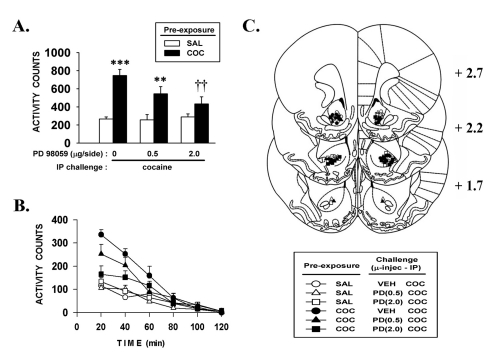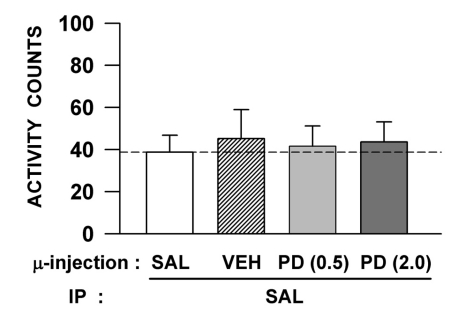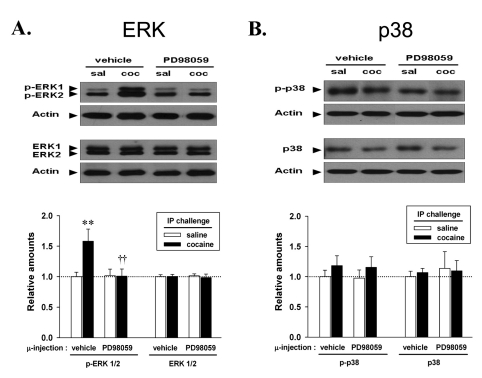Korean J Physiol Pharmacol.
2011 Dec;15(6):389-395. 10.4196/kjpp.2011.15.6.389.
Blockade of ERK Phosphorylation in the Nucleus Accumbens Inhibits the Expression of Cocaine-induced Behavioral Sensitization in Rats
- Affiliations
-
- 1Department of Physiology, Brain Korea 21 Project for Medical Science, Yonsei University College of Medicine, Seoul 120-752, Korea. jkim1@yuhs.ac
- KMID: 2285426
- DOI: http://doi.org/10.4196/kjpp.2011.15.6.389
Abstract
- Repeated administration of psychostimulants such as cocaine leads to the development of behavioral sensitization. Extracellular signal-Regulated Kinase (ERK), an enzyme important for long-term neuronal plasticity, has been implicated in such effects of these drugs. Although the nucleus accumbens (NAcc) is the site mediating the expression of behavioral sensitization by drugs of abuse, the precise role of ERK activation in this site has not been determined. In this study we demonstrate that blockade of ERK phosphorylation in the NAcc by a single bilateral microinjections of PD98059 (0.5 or 2.0micro g/side), or U0126 (0.1 or 1.0microg/side), into this site dose-dependently inhibited the expression of cocaine-induced behavioral sensitization when measured at day 7 following 6 consecutive daily cocaine injections (15 mg/kg, i.p.). Acute microinjection of either vehicle or PD98059 alone produced no different locomotor activity compared to saline control. Further, microinjection of PD98059 (2.0micro g/side) in the NAcc specifically lowered cocaine-induced increase of ERK phosphorylation levels in this site, while unaffecting p-38 protein levels. These results indicate that ERK activation in the NAcc is necessary for the expression of cocaine-induced behavioral sensitization, and further suggest that repeated cocaine evokes neuronal plasticity involving ERK pathway in this site leading to long-lasting behavioral changes.
Keyword
MeSH Terms
Figure
Cited by 1 articles
-
Predominant D1 Receptors Involvement in the Over-expression of CART Peptides after Repeated Cocaine Administration
Zhenzhen Hu, Eun-Hye Oh, Yeon Bok Chung, Jin Tae Hong, Ki-Wan Oh
Korean J Physiol Pharmacol. 2015;19(2):89-97. doi: 10.4196/kjpp.2015.19.2.89.
Reference
-
1. Kalivas PW, Stewart J. Dopamine transmission in the initiation and expression of drug- and stress-induced sensitization of motor activity. Brain Res Brain Res Rev. 1991; 16:223–244. PMID: 1665095.
Article2. Robinson TE, Berridge KC. The neural basis of drug craving: an incentive-sensitization theory of addiction. Brain Res Brain Res Rev. 1993; 18:247–291. PMID: 8401595.
Article3. Robinson TE, Berridge KC. The psychology and neurobiology of addiction: an incentive-sensitization view. Addiction. 2000; 95(Suppl 2):S91–117. PMID: 11002906.
Article4. Atkins CM, Selcher JC, Petraitis JJ, Trzaskos JM, Sweatt JD. The MAPK cascade is required for mammalian associative learning. Nat Neurosci. 1998; 1:602–609. PMID: 10196568.
Article5. Sweatt JD. Mitogen-activated protein kinases in synaptic plasticity and memory. Curr Opin Neurobiol. 2004; 14:311–317. PMID: 15194111.
Article6. Berhow MT, Hiroi N, Nestler EJ. Regulation of ERK (extracellular signal regulated kinase), part of the neurotrophin signal transduction cascade, in the rat mesolimbic dopamine system by chronic exposure to morphine or cocaine. J Neurosci. 1996; 16:4707–4715. PMID: 8764658.7. Valjent E, Corvol JC, Pages C, Besson MJ, Maldonado R, Caboche J. Involvement of the extracellular signal-regulated kinase cascade for cocaine-rewarding properties. J Neurosci. 2000; 20:8701–8709. PMID: 11102476.
Article8. Mattson BJ, Bossert JM, Simmons DE, Nozaki N, Nagarkar D, Kreuter JD, Hope BT. Cocaine-induced CREB phosphorylation in nucleus accumbens of cocaine-sensitized rats is enabled by enhanced activation of extracellular signal-related kinase, but not protein kinase A. J Neurochem. 2005; 95:1481–1494. PMID: 16219028.
Article9. Valjent E, Corvol JC, Trzaskos JM, Girault JA, Hervé D. Role of the ERK pathway in psychostimulant-induced locomotor sensitization. BMC Neurosci. 2006; 7:20. PMID: 16512905.
Article10. Perugini M, Vezina P. Amphetamine administered to the ventral tegmental area sensitizes rats to the locomotor effects of nucleus accumbens amphetamine. J Pharmacol Exp Ther. 1994; 270:690–696. PMID: 8071860.11. Cador M, Bjijou Y, Stinus L. Evidence of a complete independence of the neurobiological substrates for the induction and expression of behavioral sensitization to amphetamine. Neuroscience. 1995; 65:385–395. PMID: 7777156.
Article12. Ferguson SM, Fasano S, Yang P, Brambilla R, Robinson TE. Knockout of ERK1 enhances cocaine-evoked immediate early gene expression and behavioral plasticity. Neuropsychopharmacology. 2006; 31:2660–2668. PMID: 16407894.
Article13. Pierce RC, Pierce-Bancroft AF, Prasad BM. Neurotrophin-3 contributes to the initiation of behavioral sensitization to cocaine by activating the Ras/Mitogen-activated protein kinase signal transduction cascade. J Neurosci. 1999; 19:8685–8695. PMID: 10493769.
Article14. Pellegrino LJ, Pellegrino AS, Cushman AJ. A Stereotaxic Atlas of the Rat Brain. 1979. 2nd ed. New York: Plenum.15. Paxinos G, Watson C. The Rat Brain in Stereotaxic Coordinates. 1997. 3rd ed. New York: Academic Press.16. Gerdjikov TV, Ross GM, Beninger RJ. Place preference induced by nucleus accumbens amphetamine is impaired by antagonists of ERK or p38 MAP kinases in rats. Behav Neurosci. 2004; 118:740–750. PMID: 15301601.
Article17. Miller CA, Marshall JF. Molecular substrates for retrieval and reconsolidation of cocaine-associated contextual memory. Neuron. 2005; 47:873–884. PMID: 16157281.
Article18. Valjent E, Pascoli V, Svenningsson P, Paul S, Enslen H, Corvol JC, Stipanovich A, Caboche J, Lombroso PJ, Nairn AC, Greengard P, Hervé D, Girault JA. Regulation of a protein phosphatase cascade allows convergent dopamine and glutamate signals to activate ERK in the striatum. Proc Natl Acad Sci U S A. 2005; 102:491–496. PMID: 15608059.19. Wolf ME. The role of excitatory amino acids in behavioral sensitization to psychomotor stimulants. Prog Neurobiol. 1998; 54:679–720. PMID: 9560846.
Article20. Vezina P, Kim JH. Metabotropic glutamate receptors and the generation of locomotor activity: interactions with midbrain dopamine. Neurosci Biobehav Rev. 1999; 23:577–589. PMID: 10073895.
Article21. Kim JH, Perugini M, Austin JD, Vezina P. Previous exposure to amphetamine enhances the subsequent locomotor response to a D1 dopamine receptor agonist when glutamate reuptake is inhibited. J Neurosci. 2001; 21:RC133. PMID: 11222671.22. Pierce RC, Bell K, Duffy P, Kalivas PW. Repeated cocaine augments excitatory amino acid transmission in the nucleus accumbens only in rats having developed behavioral sensitization. J Neurosci. 1996; 16:1550–1560. PMID: 8778304.
Article23. Vanderschuren LJ, Kalivas PW. Alterations in dopaminergic and glutamatergic transmission in the induction and expression of behavioral sensitization: a critical review of preclinical studies. Psychopharmacology (Berl). 2000; 151:99–120. PMID: 10972458.
Article24. Zhang L, Lou D, Jiao H, Zhang D, Wang X, Xia Y, Zhang J, Xu M. Cocaine-induced intracellular signaling and gene expression are oppositely regulated by the dopamine D1 and D3 receptors. J Neurosci. 2004; 24:3344–3354. PMID: 15056714.
Article
- Full Text Links
- Actions
-
Cited
- CITED
-
- Close
- Share
- Similar articles
-
- Cocaine-Induced Behavioral Sensitization in Mice: Effects of Microinjection of Dopamine D2 Receptor Antagonist into the Nucleus Accumbens
- Predominant D1 Receptors Involvement in the Over-expression of CART Peptides after Repeated Cocaine Administration
- Ritanserin, a 5HT2/1C receptor antagonist, does not block cocaine-induced behavioral alterations and zif268 mRNA expression in the striatum of the rats
- Effects of Clozapine, Haloperidol, and Fluoxetine on the Reversal of Cocaine-Induced Locomotor Sensitization
- Decrease of glycogen synthase kinase 3β phosphorylation in the rat nucleus accumbens shell is necessary for amphetamineinduced conditioned locomotor activity





